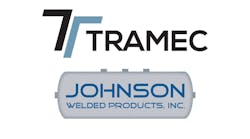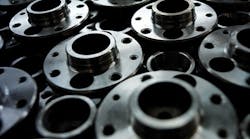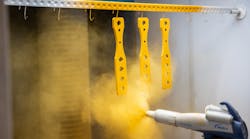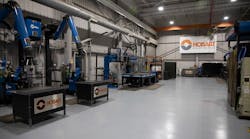FOR MORE THAN 20 YEARS, 4-Star Trailers built its custom aluminum horse trailers by welding the components together. So the company initially was skeptical about using adhesives.
But in partnering with LORD Corporation — a pioneer in specialty structural adhesives, polyurethane coatings, and electronic, vibration, and noise-control solutions — a different picture emerged.
4-Star learned that several major automotive manufacturers, including DaimlerChrysler, General Motors, Ford, Volvo, Nissan, Mazda, and Mitsubishi, had used structural adhesives supplied by LORD Corporation on more than 10 million cars for 15 years.
Kris Coleman of DTI, LORD Corporation's distributor, provided several samples for the tests.
4-Star, understanding the importance of providing structurally-sound trailers with tight doors, worked with LORD to develop a specialty structural adhesive for its trailer doors that ensures optimal strength.
“We chose adhesives formulated by LORD Corporation after reviewing the motives of these large automotive corporations for choosing them for bonding roof and door panels,” said Butch Patchell, manager of research and development for 4-Star Trailers. “Attributes such as impact resistance, vibration, and noise-dampening as well as superior strength were among those cited, which is exactly what our customers want.”
Testing the technology
For a two-year period, 4-Star conducted extensive testing to develop fixtures and test the strength of their bonded designs.
Patchell said that the door shop was the ideal place to try the adhesives. Two doors were created for the testing process — a traditional welded door (with taped and riveted outer panels) and one constructed entirely using adhesives, both of which were hung to a heavy steel frame.
A hole was drilled in the lower corner of the door to simulate where a horse may kick and the panel would experience the most stress. Then, the chain from a ¾-ton winch was threaded through the hole. On the welded door, at 40 lb of force, the door pulled off the frame. At 950 lb of force, the door pulled out 5.5" and broke apart.
In contrast, at 1000 lb of force from the winch, the bonded door had only pulled out ½". The team was so amazed with the results that it bought a three-ton winch, hooked it up, and performed the test again. Only when 2,500 lb of force was applied did the bonded door move 1".
The same test was repeated again at a later date for the non-believers. This time, the welded door was irreparably damaged at approximately 960 lb of pressure. Because the team never broke the adhesive door on the first test, it set out to find the breaking point by adding 800 lb per stroke of the winch. Somewhere between 4000 lb and 4400 lb, the door popped loose, but when they released the winch, it went back to its original position and laid flat with easily repairable damage.
Another test involved using adhesives on small feed doors and placing them in a freezer maintained at -20°F. The doors, which were shuttled from the freezer to the outdoor sun and back several times over the course of a week, experienced no change with the temperature difference. Patchell said this was important because thermal expansion problems are common with welded components.
Yet another test involved the use of a high-powered vibrator hooked to the door. Although the welded door quickly failed, the adhesive door never fell apart though the hinges eventually wore out from the heavy vibration.
According to Patchell, the bonded doors outperformed welded, taped, and riveted doors in every test. Therefore, it was determined that the bonded doors were four times stiffer with double the impact resistance of 4-Star's welded doors. This stiffness prevented the door from flexing as easily and provides excellent security for cargo.
“The doors were frozen, baked, dropped, pulled, and hammered,” Patchell said. “We conducted these tests repeatedly because we could not believe how much stronger the bonded door was when compared to the welded door. Our welded doors were considered the best in the industry because the frames were welded and then the skins were taped onto them using double-side acrylic adhesive tape, as well as riveted for good measure. This is why we were initially skeptical when we were shown an adhesive that was more effective than all those measures.”
Unlike welded doors, a bonded door cannot warp out-of-plumb because of its superior stiffness. As such, 4-Star Trailers developed a new process for attaching doors to the trailer. The new approach involves pre-assembling the door to a door jamb and then attaching the pre-hung door assembly to the trailer. This design maintains a uniform gap between the door and its sealing surface all around the door, which allows the rubber seal to have equal compression with no gaps. Further, the lack of gaps contributes to much better water resistance than previous designs.
Proof is in the numbers
Although strength and durability are key, 4-Star also sought a more efficient and cost-effective solution. Since integrating adhesives into their door assembly, Patchell said, 4-Star has realized tremendous savings in labor and materials.
Not only has 4-Star been able to reduce labor by 50%, but the switch from rivets, adhesive tape, and welding to adhesive bonding also results in savings for 4-Star. The savings enables 4-Star to reinvest in improved designs for its hinges and door jambs. Because of this success, 4-Star is experimenting with bonding the floor panels. In addition, the adhesives are expected to be a quieter solution, which is important in reducing the stress horses experience during transport.








